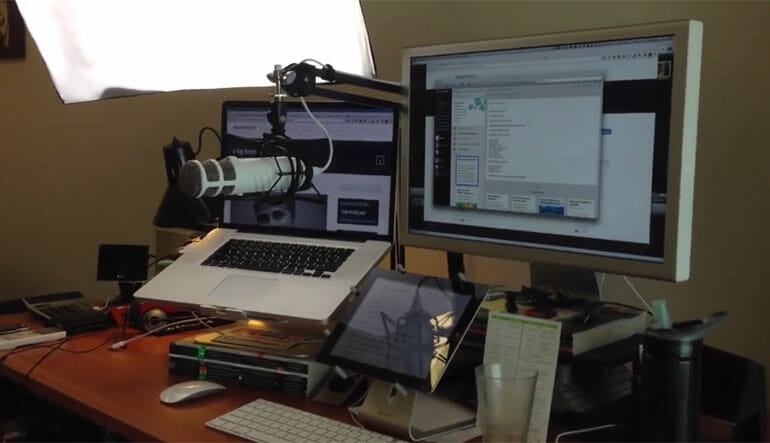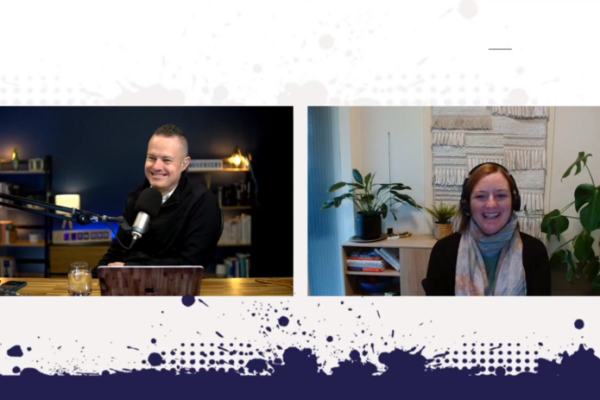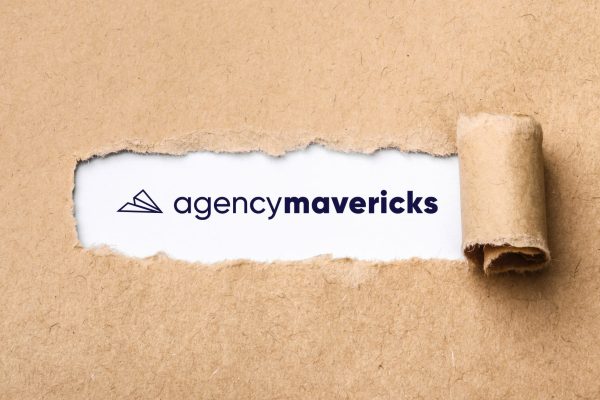G’day Troy Dean here from Agency Mavericks. I interviewed Dan Norris, from WP Curve, earlier today on the Agency Mavericks Podcast, and we got chatting about processes and systems in our respective businesses. I thought it might be interesting to walk you through the system and the process that we have in place to produce an episode of the Agency Mavericks Podcast.
I'm going to walk you through the process of exactly what's involved from right at the beginning, where we approach someone and ask them to be on the podcast and secure that interview, right through to the point where the interview is published on the podcast as a blog post, and all the steps involved, partially so that we can make sure our processes are tight. Publishing it publicly is a good way of seeing all the holes in the process, warts in all so to speak, and also so that you guys can see what's involved in putting together a weekly podcast like the Agency Mavericks Podcast. So, let's take a look at what's involved.
Watch The Video Walkthrough of the Agency Mavericks Podcast
Securing The Guest
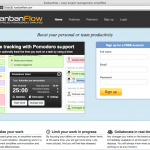 The first thing that happens is I add someone to our kanban board. A kanban board, for those of you that don’t know, is a board of columns that outline a process that needs to happen. On our kanban board, we have a column for people to contact, a column for people where contact has been made, a column when the interview is booked, a column when the interview is done, and then a final column when the interview is published.
The first thing that happens is I add someone to our kanban board. A kanban board, for those of you that don’t know, is a board of columns that outline a process that needs to happen. On our kanban board, we have a column for people to contact, a column for people where contact has been made, a column when the interview is booked, a column when the interview is done, and then a final column when the interview is published.
My first job is to come into the kanban board, we use kanbanflow.com, or you could use Trello; it doesn’t really matter what tool you use, and I add someone to this column here to contact. In this case, I just interviewed Dan, from WP Curve, and he suggested that I get Brendan Sinclair on the podcast. All I'm going to do is add Brendan Sinclair to the kanban board and my description will be here (author of The Web Design Business Kit for SitePoint, based on the Gold Coast). Then, what I'm going to do is I'm going to assign this to Kristen and she will get a notification that I’ve added Brendan to the kanban board, and then she will know what to do next. I'll show you what happens in the process.
Brendan has been added to the kanban board and Kristen gets a notification to let her know, and then she will follow the next step in the process, which I'll show you now.
The next step will be for Kristen to schedule the interviewee and we use Asana to keep track of all of our processes. Kristen will come in and have a look at the “scheduling interviewee: process here and I'm just going to put this in full-screen mode. The first thing she will do is log into Kanbanflow and under “To Contact,” under this column here, “To Contact,” she'll click on a name. If there are contact details there, great, if not, find it. She'll go and do some research and find the contact data for that person and try and find out what time zone they're in, as well.
The good thing about Asana is in the comments here, you can leave screen shots of what the process looks like, so if someone is not familiar with these tools they can just see straightaway what it is they need to be doing. Once Kristen has found the contact details for this person, she will then go and look at my calendar page; I use ScheduleOnce to run my calendar page. She'll come and look at my calendar page and she'll look for open appointments available at a reasonable time for the interviewee, using whatever time zone they're in that might be an appropriate time.
This is really important: Kristen will then make note of at least three open appointments in my calendar, and the whole purpose of this is to make it super easy for the person that we want to interview to say yes. Kristen will come and have a look here, and what she might do is she might choose a different time zone. Let's just say she'll choose United States Pacific Time, if that’s where the person is, click on OK, then she'll come and have a look at my schedule. Let's just have a look in January, because I'll have some time there. She might click on the 8th. Okay, there's plenty of time here that we can do interviews on the 8th. Lets have a look at the 2nd; there's a few spots left on the 2nd, and there's plenty of time left on the 7th. She might pick three of those and then put them together in an e-mail.
She will then compose the e-mail here, using the template that we've attached … this e-mail template here, and I'll walk you through why this is important. This e-mail template has been written strategically to let the person know that we have done our research on them and that we actually think they would be a good fit for our audience. This e-mail says something like this: “Hi, Paul. I'm e-mailing on behalf of Troy Dean at Agency Mavericks because we'd like to promote you to our database of over 8000 WordPress consultants.” Straightaway, that gets their attention; who doesn’t want to be promoted to a database of over 8000 WordPress consultants, if they're in the WordPress space? “We are big fans of,” whatever it is they do, “and we are sure our audience will love hearing from you.”
For example, when we approached Dan, from WP Curve, we said, “We’re big fans of WP Curve and we're sure our audience will love hearing from you.” This is true. We only interview people who we actually are big fans of and we think our audience will get value from. “Troy would like to do this by interviewing you for our podcast, which has previously featured people such as blah, blah, blah, blah, blah,” and that’s just a bit of credibility there. Then there's a link where they can see the podcast in action, to see that we are the real deal.
“If you are keen, I will send through some questions in advance. The interview should take about half an hour. Given that Troy is in Australia, I’ve taken the liberty of suggesting a few times where your time zones line up for a potential spot.” Then Kristen will insert the three time slots here, and then sign off by saying, “Looking forward to your response.”
This sets up their expectations, “The interview should take about half an hour.” In truth, it takes about 45 minutes, but we try and set up their expectation and say, “Look, it's not going to take very long. We love what you're doing; we want to promote you to our database. They’ll love hearing from you. This is a win-win for everyone, and we've done all the work. Here are three time slots that you can choose from, looking forward to your response.” We try and make it as easy as possible for the guest to say yes. Once that e-mail has been composed, Kristen will – it's quite particular here, really, seriously, check the time zones, double-, triple-check the time zones that you’ve got them right, and then send the e-mail.
Once you’ve made contact, log in to Kanbanflow and drag the contact's name to the appropriate column. In this case, she would just pick out Brendan's name and she would drag it to the “Contact Made” column and then we know that we're waiting to hear back from that person. I'll just pop Brendan back there for now. Once you settle on a meeting time – oh, here we go, bonus point. Add in a little note with the contact info, it helps other people. Kristen will add a little note to Brendan's card in the kanban board that might help me when I'm doing my research for the interview.
Once you settle on a meeting time and make sure that they’ve got Skype and they're okay to do a Skype video chat, make sure to share Troy's Skype name. Log on to my calendar and then finalise the “Open Appointment” slot. Kristen will come in here and she will tick a time, put in the interviewee's name and e-mail address, and I will receive an e-mail telling me that that interview has been scheduled. Click “Continue,” the scheduling information will automatically be sent to the interviewee, and I get it as well, which is awesome. That process is done, for scheduling the interviewee.
Really, from here, what happens is I then plan the interview and send the interview questions to the interviewee in advance, so that they can get an understanding of what we're going to talk about. I'll show you that process right now.
Planning The Questions
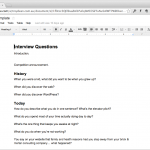 In Google Docs here, I have a document called “Interview Questions Template.” If I click on that, this is the template of interview questions that we ask, and it's a bit of a running sheet for me as well. I always go through an introduction and I always announce a competition. The reason that we have a competition is because we want people to engage with the interviews and the podcast. We want people to leave comments; it's great for building a community. The best way to encourage people to leave comments is to dangle a carrot and offer a prize, so we always offer a prize, whether it be software or a book of the person that we're interviewing, or whether it be our own software, or a coaching session with myself, or an Amazon voucher. We always offer a prize to encourage engagement.
In Google Docs here, I have a document called “Interview Questions Template.” If I click on that, this is the template of interview questions that we ask, and it's a bit of a running sheet for me as well. I always go through an introduction and I always announce a competition. The reason that we have a competition is because we want people to engage with the interviews and the podcast. We want people to leave comments; it's great for building a community. The best way to encourage people to leave comments is to dangle a carrot and offer a prize, so we always offer a prize, whether it be software or a book of the person that we're interviewing, or whether it be our own software, or a coaching session with myself, or an Amazon voucher. We always offer a prize to encourage engagement.
Once I get through the introduction, we then go through a bit of history, which, if you’ve heard the podcast, this will all be very familiar to you. Then we talk about where they are at today and what they're doing today. Then we talk about the book or the software that they're currently working on, or that they're currently promoting. Then we go through the Elevation Round, which is always the same. Then we talk about the future, and then we wrap up and conclude. Lastly, I ask them who they would like me to interview. I stole that from Andrew Warner, from Mixergy, and I don't know where he stole it from, but I'm sure he stole it from somebody. That's where I stole that from. Thank you very much, Andrew.
What I do now, if I'm interviewing Brendan, for example, I'll just go through here and I'll do some research on Google on Brendan, and I'll start changing things about here. This is all pretty standard. Then I'll say what research I’ve done. I'll write some questions here. I'll change this section here, based on what Brendan's up to today and what he's promoting. This usually takes me about 10 minutes to do this research and change these questions. I'll leave the Elevation Round as it is, because I want to ask the same questions of all of our guests, to give our audience some advice. Our audience are predominantly WordPress consultants and freelancers, and I want our audience to get the same questions form different guests, to get different perspectives.
I probably won't change anything here. I might just say, “What's the future for,” whatever company it is they're working on at the moment, or the start-up they're working on, and then we conclude. Then, what I do is I just download that as a PDF and I e-mail it to the interviewee with a little note saying, “Hey, we usually run a competition when we do these interviews. Would you like to sponsor a copy of your book or a couple of months access to your software? There's no obligation, but if you would like to, great. If not, I'm happy to sponsor an Amazon voucher.”
What I might do is, I might say, “If you don’t want to do that, that’s okay. I might buy a copy of your book, if that's okay and give away as part of the competition.” That way, our guest can get some research out of our audience, because we usually ask, “What's the number one thing you would like to see in a future version of this person's software,” or, “What's the best thing you learned from the book,” or, “If they were going to write a book in the future, what would you like them to write a book about?” Those kinds of things, so that our guests get some market research and that our viewers and our listeners get an opportunity to engage with the interview and enter a competition. Then I ask the guest to come back in a couple of weeks after the interview has gone live and award the prize of that competition. That kind of closes that loop.
Recording and Editing The Interview
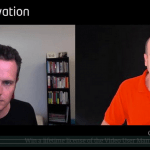 From here, what happens is I literally get on Skype, we set up a video chat. I use Ecamm. I use Call Recorder for Skype by Ecamm; I'm on the Mac. I use this software here to record the call. Then what I do is, once the call is recorded, it gets saved into my “Saved Calls” folder, which you can see here. What I do is, I literally just throw that into a Dropbox folder. In Dropbox I have a folder called “Agency Mavericks Interview Videos.” I set up a new folder for this particular interviewee, and I grab the saved Skype call and stick it in there. Then I send Kristen an e-mail instructing her to give instructions to our video editor in the States, so that he can edit the video and put it together. I'll show you what that looks like right now.
From here, what happens is I literally get on Skype, we set up a video chat. I use Ecamm. I use Call Recorder for Skype by Ecamm; I'm on the Mac. I use this software here to record the call. Then what I do is, once the call is recorded, it gets saved into my “Saved Calls” folder, which you can see here. What I do is, I literally just throw that into a Dropbox folder. In Dropbox I have a folder called “Agency Mavericks Interview Videos.” I set up a new folder for this particular interviewee, and I grab the saved Skype call and stick it in there. Then I send Kristen an e-mail instructing her to give instructions to our video editor in the States, so that he can edit the video and put it together. I'll show you what that looks like right now.
Here's the canned response that I have set in Gmail. It says, “Hey, Kristin. I’ve added a new interview to the Dropbox for Chris to edit, please. This is the folder, Dropbox Agency Mavericks Interview Videos.” Then I'll just type the guest's name there. It'll be Brendan in this case, Brendan Sinclair, and then, “Here are the instructions: The intro,” and we have a standard introduction to the podcast. Then I'll say, “The video, BrendanSinclair.mov.” There's usually a bit of talk, a bit of chat at the start between myself and the guest, just to test the recording is working, and then the interview usually starts a few second into the actual video, into the movie file. I'll say, “This will start at,” for example, “23 seconds, and it finishes at 45 minutes, 15, and then the interview is over.”
In the bottom third, my name should appear as Troy Dean, Agency Mavericks, and our guest's name should appear as Brendan Sinclair. I'm sure I'm spelling his name wrong, and I know he doesn’t work at SitePoint anymore, but I'm going to put that anyway. Then, “The details to the contest that appear in the bottom third are: Win blah, blah, blah, blah, blah. If you can get Chris to edit this together, please, and put the video in Vimeo, and the audio file in Amazon S3 by the end of the week, that would be great,” and I hit “Send.”
Kristen then gets that and she communicates with Chris using Odesk, and she gives Chris this e-mail, basically. Chris then goes and works his magic. He grabs the videos, he edits them together, he uploads the video directly into the Vimeo, our Vimeo Pro account, and he uploads the audio file directly into our Amazon S3 bucket, and he's got all the details for that. He sets the permissions on the MP3 file on Amazon S3 so that we can then use that as the podcast file. In the next section of this, I'm going to show you how we actually, now that we've got all the assets ready, how we actually publish the blogpost.
Hit The Publish Button
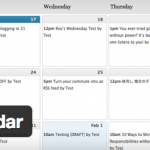 The final piece of the puzzle is the actual blogpost. I just come into WordPress. I’ve usually got some posts scheduled on the calendar, using the Editorial Calendar plugin. If not, just create a new post, type in the episode number, and the guest's name. In this case, it was Miriam Schwab. Then I just write a brief introduction here to the interview. I use the “Insert More” tag here to split the blogpost. I then go to the Vimeo Shortcode. We use the “Advanced Responsive Video Embed” plugin. I’ve just got a shortcode here for the video file and I just grab the ID of the video from Vimeo and stick it in here.
The final piece of the puzzle is the actual blogpost. I just come into WordPress. I’ve usually got some posts scheduled on the calendar, using the Editorial Calendar plugin. If not, just create a new post, type in the episode number, and the guest's name. In this case, it was Miriam Schwab. Then I just write a brief introduction here to the interview. I use the “Insert More” tag here to split the blogpost. I then go to the Vimeo Shortcode. We use the “Advanced Responsive Video Embed” plugin. I’ve just got a shortcode here for the video file and I just grab the ID of the video from Vimeo and stick it in here.
Then I’ve got this “Alert Box” that I’ve got set up using Symple Shortcodes, and I just put in the details of the contest here. Then I give a bit more information about the interview, some of the stuff that our guest is working on, and some outbound links. Then, where you can reach out to our guest, that is Miriam, not Brad, you can reach out and thank Miriam on e-mail or on Twitter; this all comes from the interview. Then Miriam suggested who I interview, and then I sign off with a little hint to further encourage engagement in the video, because people generally won't watch the whole interview to learn how to enter the competition. I just leave a little hint to encourage more comments, to get people to leave more comments.
I put this in the “Podcast” category and then we use the PowerPress plugin by Blubrry, I think it is. I come down here and I grab the URL from Amazon S3 and I paste it in here and verify it, so that it is verified as a playable audio file by podcast software. I don’t protect this; this is public content, so it's not part of our membership site. Then I go and find a beautiful image of our guest that’s at least 770 pixels wide, and I add that as the featured image. Then I make sure it's set to the right date; we publish podcast episodes every Thursday. Once that is set to the right date, I then publish it.
On the front-end of the site, all of this work comes together and it looks like this. In the podcast we have Episode 12, Miriam Schwab, beautiful, big hero image of our guest there, and we have – in fact, let me just go to the blog and show what it looks like on the blog page, rather than the post page. We have the episode number and the name. We have the hero image there. We have the excerpt there. The podcast episode is here; you can play it straight up. Here's ones I’ve done previously, Brad, from Delicious Brains, Andrew Dumont, from Moz, Collis Ta'eed, from Envato.
That is the process to actually get these blogposts published. If you click through onto one of the individual episodes, here's the video chat recording from Skype. Here's the Alert Box with the interview details. Here are all the links here, and again here is the episode here, and people will leave comments. This has just been published. People will leave comments underneath.
Spread The Word
Then the only final step is, I log in to GetResponse, and I send an e-mail to our entire database of, I think we're up to about 9000 now, letting people know that I’ve published a new episode on the podcast and what they can expect to learn from it, and the prize that they might be able to win. People come to the website, watch the podcast, watch the video, download it on iTunes, leave comments, and people win prizes. That, in a nutshell, is how we manage the podcast.
Technical Setup
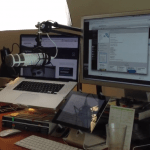 Now I'll just walk you through a couple of technical things and some of the equipment that I use. This is the setup for recording Skype interviews for the podcast. The first thing I'm going to show you is my stand-up/sit-down desk. This desk here has two buttons here that I can push at the same time and the whole thing just lifts up, as you can see, and you’ve got the right level. The sit-down/stand-up desk allows me to get up and down throughout the day, which is great for keeping my energy up and also good for lower back problems.
Now I'll just walk you through a couple of technical things and some of the equipment that I use. This is the setup for recording Skype interviews for the podcast. The first thing I'm going to show you is my stand-up/sit-down desk. This desk here has two buttons here that I can push at the same time and the whole thing just lifts up, as you can see, and you’ve got the right level. The sit-down/stand-up desk allows me to get up and down throughout the day, which is great for keeping my energy up and also good for lower back problems.
I then have a MacBook Pro, as you can see there, and it's connected to a 23-inch cinema display screen. I have my iPad on a little stand from Luxa2 here for the questions, so that I can see the questions while I'm interviewing the person on Skype. I just use the camera that is in the MacBook Pro, the beautiful HD camera in the MacBook Pro, to record the interview on Skype. I usually have Evernote open here, where I can take notes during the interview. I have my beautiful Rode Podcaster Microphone here on the PSA1 boom arm, which you can see connected to the back of the desk there. That boom arm comes up over the top, in between the monitor and the laptop, and is in a good position for me to speak into.
I usually hide my desk lamp behind the computer so that I can bring in my softbox light here, over the top of the laptop. You can see that’s on a stand here with a sandbag for weight. I bring that into position so that when I'm standing in front of the MacBook, speaking into the microphone, there's a nice light right in my face, so that I'm well lit, so that people can see me and with the microphone people can hear me. That is the setup for recording interviews. I usually turn Dropbox syncing off and turn all my notifications off, so nothing pops up during the interview. I normally put a note on my door that says, “Recording in Progress,” so people don’t walk into my door. It's pretty quiet in here, and I haven’t had too many problems.
That’s the setup for recording an interview of the Agency Mavericks Podcast. That's the equipment. I'll leave links to everything that I’ve mentioned in the notes underneath this video. I hope that helps. Please, leave me a comment under this video and tell me what you learned from this video, or what you would like to see me do in the future episodes of the Agency Mavericks Podcast to keep the conversation going. I hope that helps.
Until next time, Go Elevate.
